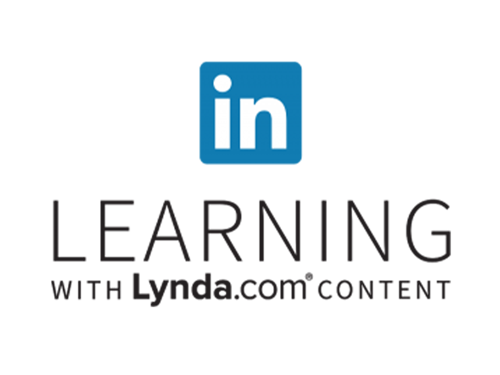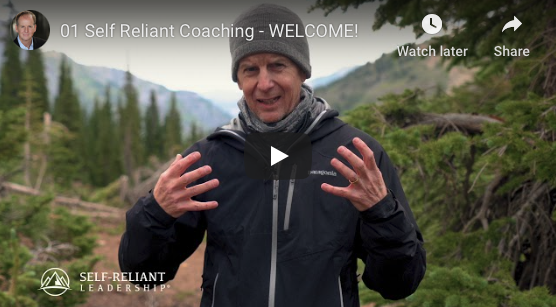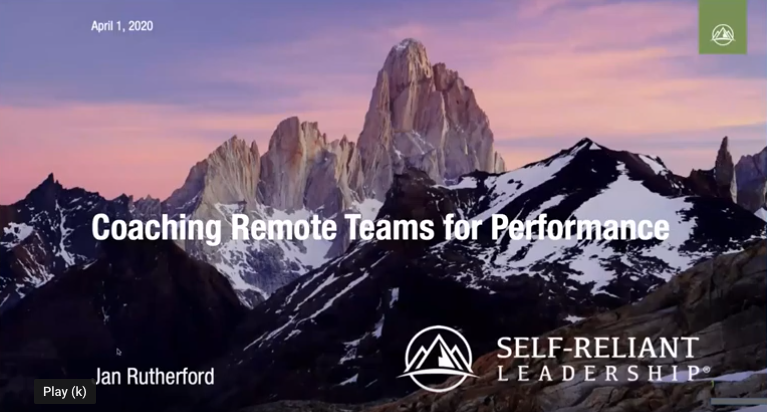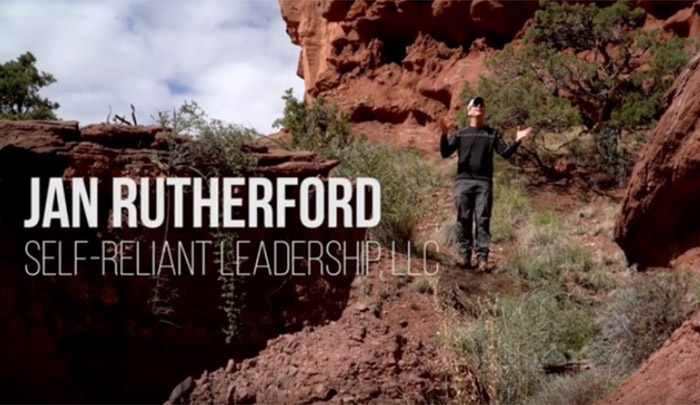Online Courses
Self-Reliant Leadership®
Cultivate Grit. Amplify Action.
“If you want to transform the team’s performance, you must first transform your performance.”
- Jan Rutherford
Investing in yourself isn't selfish.
It's the most worthwhile thing you can do. Leadership development is a lifelong journey, and that investment involves sacrifice, determination, and discipline.
If you’re not seeing the Ownership, Accountability, and Alignment you’d like to see on your team, and the first place you look is the mirror, then you are in the exact right place!
Our dynamic courses contain over 130 videos, and are designed to take your leadership abilities to new levels by tackling common leadership challenges.
The digital courses are self-paced, and the videos average five minutes in length, and provide specific takeaways.
We provide three channels to view our online courses:
LinkedIn Learning Courses

If you’re already a LinkedIn Premium member you can gain immediate no-cost access to Self-Reliant Leadership® courses on LinkedIn Learning. Simply choose a course below for immediate access.
Grit: How Teams Persevere to Accomplish Great Goals with: Jan Rutherford
In this visually stunning and inspiring business narrative, filmed on location in the Rocky Mountains, leadership expert Jan Rutherford and a team of nine professionals dig deep to persevere and deliver on a collective goal—demonstrating a set of skills we call "grit."
This course can help you and your team identify what it will take to move beyond simply good and get to what is great. Use the additional downloadable exercise files to help embed these practices in your daily work as an individual and as a larger team.
CONTENT
- Building trust
- Preparing for performance
- Communicating
- Developing perspective
- Sharing a purpose
- Introduction – Cultivating grit on your team
- Building trust on your team
- Communicating on your team
- Developing perspective to lead
- Achieving a common purpose on a team
How Leaders Generate Energy and Cultivate Commitment
Managing in Difficult Times
Tough times separate great leaders from the rest of the pack. What do leaders do to manage effectively in difficult times? It’s as much about what they do to prepare as it is about how they react. In this program, Jan Rutherford introduces you to important tools for keeping you and your team focused, inspired, and effective during times of change or crisis.
You’ll gain insights into how to build self-awareness, achieve clarity and focus, keep innovating despite volatility, and develop a committed team that is resilient in the face of change. He also shares innovative strategies to cut costs, and reframe challenges as opportunities for your team.
CONTENT
Creating Awareness in Difficult Times
1. Identifying difficult times from the perspective of an executive
2. Looking through your employees' eyes
3. Assuming responsibility for the new norm
4. Revisiting past performance
Applying strategies to stay focused
5. Eliminate multitasking
6. Placing people at the core
7. Creating value in different ways
Strategies for Innovation
8. Adopting a growth mindset
9. Eliminating the status quo
10. Staging for innovation
Developing a Committed Team
11. New take on the balanced scorecard
12. The cascading strategy map
13. Making the roster every day
14. "Controllables"
15. Alternative approaches to cost reductions
Reducing Staff Related Costs
16. Ties that bind - Gluing people to the organization
17. Rev up operating velocity
Responding in Difficult Times
18. Becoming a Change Agent
19. Ownership mentality
20. Messaging is a Two-way street
21. Conclusion – Next sustaining steps
Leading the Organization Monthly
Moving to the C-Suite requires a mindset shift. The paradox is that it means leading less and delegating more to create an environment where people are inspired to do their best. If you’re transitioning from leading others to leading the organization, this course offers insights that help you advance your leadership skills and adapt to the realities of an executive role.
You’ll discover how to inspire confidence, delegate work, identify talent, lead multiple generations, and build a company vision, strategy, and culture. Each month, consultant and former CEO Jan Rutherford provides new techniques that will help you succeed in a C-Suite role.
CONTENT
Controlling the Organization
1. Understand what you control
2. Influence your Organization
3. Learn to Delegate
Shaping the Environment
4. Leadership "Levers"
5. Incentives Other Than Money
6. Generational Engagement
Why Leading Less Means Leading More
7. Look for Three Traits in Employees
8. Let Your Team Help You
9. Be Aware of Fear and Complacency
People Support What They Help Create
10. An Equation for Effectiveness
11. Get Past Bias
12. Create a Culture of Thought Diversity
Hard to Focus Until You Nail the Chaos
13. Defining the Meaningful Outside
14. Establishing the Focal Point
15. Overcoming Resistance
The Three Priorities
16. Targets versus Markets
17. Values versus Priorities
18. Current versus Future Yield
The Art of the Question
19. Questions to Align on The Why
20. Walking Around Questions
21. Powerful Coaching Questions
High Performance Habits
22.. Prioritize Priorities
23. Standards versus Expectations
24. Performance Consequences
Fostering a Highly Engaging Environment
25. Motivators versus Demotivators
26. The Fairness Ratio
27. Abate Team Disfunkshin (sic)
Metrics to Ignore
28. Relationships versus Results
29. Personality versus Behavior
30. We Need PONR's-Point of No Return Goals
Solitude and Leadership
31. Hearing the unheard
32. Creating White Space
33. Leading Self
Measured Executive Presence
34. It's not about you
35. Leadership Essence
36. The Pressure Test
Managing Temporary and Contract Employees
There are more contractors, freelancers, part-timers, temps, and self-employed workers than ever—over 42 million in the U.S. alone. As a result, managers of temporary and contract workers have to juggle staff who are frequently off site, who schedule their own hours, and who may have little experience with your company’s mission—but who work alongside full-time employees.
In this course, leadership consultant Jan Rutherford helps you understand the reason for the rise in the number of contract and temporary personnel, and why it’s important to integrate them cohesively into your teams. He reviews best practices for hiring, onboarding, and communicating with contractors, and how to use the time you spend with them effectively.
He also explains the mindset of a temporary worker and provides suggestions for ways to motivate a blended team and create real and lasting alignment with the rest of your organization.
CONTENT
The Case for Temp and Contract Employees
1. New paradigms for talent acquisition
2. Budget mindfulness
Onboarding and Hiring Processes
3. Selecting is an ongoing process
4. Onboarding to engage employees
Tips for Time Management
5. Juggling temp and contract employees
6. Balancing tasks and relationships
Motivation for Your Temp and Contract Employees
7. Communicating clearly and efficiently
8. Motivating intrinsically
9. Considering incentives
10. Engaging your contract employees
Strategies for Organizational Alignment
11. Creating Operational Manuals
12. Clarifying goals and objectives
13. Upholding the standards
Strategies for Inclusion
14. Aligning as one team
15. Converting contractors to full-time
16. Conclusion – Next steps
WORK STORIES: Experiences that influence careers - Jan Rutherford: Learning to Leverage People’s Strengths
Things happen at work sometimes things you never could have anticipated. Unexpected experiences often teach you important lessons about work and about yourself. In this short course, Jan share stories of his work leading expeditions, and includes professional and personal anecdotes about events that have helped inform and influence his career.
Learning Path: Developing Resilience and Grit
Not a LinkedIn Premium Member? - No Problem
LinkedIn Learning is making a free month of LinkedIn Learning available to Self-Reliant Leadership® followers so you can enjoy all the benefits of LinkedIn Career Premium membership, including free access to my LinkedIn Learning courses.
Jan's Teachable Courses
Three in-depth courses for you and your team - and two completely free resources as well!

Self-Reliant Coaching™
Shot on location in Ouray, Colorado, this course includes 9 video lessons – each less than five minutes in length – that address the the Three Pillars of Self-Reliant Leadership: Leading Self, Leading Others, and Leading the Organization.
Each video lesson is supported by a comprehensive Course Guide that learners use to target specific behaviors that are key to effective Self-Reliant Coaching™.
The Course Guide is comprised of:
- Video Summaries
- Ideas for Action
- Questions for Contemplation
- Resources for Further Exploration
CONTENT
1. WELCOME! (1:51) – Course overview and expectations
Leading Self – by assuming Ownership and demonstrating GRIT
2. VALUES (2:48) - Articulating what you value
3. THE IDEAL (4:00) - Describing what you want
4. DISCIPLINE (4:07) - The importance of journaling
Leading Others – by establishing Accountability and a sense of DUTY
5. SETTING EXPECTATIONS (3:03) - Invest time up front
6. KEY QUESTIONS (3:24) - Find the strengths in others
7. DIFFICULT CONVERSATIONS (5:06) - Courageous expectation setting
Leading the Organization – by setting a realistic PACE while creating alignment & focus.
8. ENVIRONMENT IS A DESIGN ISSUE (5:01) - People support what they help create
9. LEADERSHIP LEVERS (4:08) - Finding the root cause of issues
10. WHAT ONLY YOU CAN DO (4:00) - Focus
11. SUMMARY (3:18) – Leading Self – Slow down to speed up.
SELF-RELIANT LEADERSHIP® WEBINARS - FREE!
There is a new webinar each quarter on current leadership challenges.
CONTENT
- Coaching Remote Teams for Performance - with thought leaders: Scott Mann, Jim Vaselopulos, Chris Kolenda & Tim Cole.
- Managing Remote Teams
- Making Decisions
- The Biggest Mistake Leaders Make
- How to have that dreaded conversation
- Adaptability
- Why Low Tech, Gritty and Green Makes Teams
- Grit: How Teams Persevere to Accomplish Great Goals
- Embracing Adversity as the Crucible to Strengthen Character and Culture
The Three Pillars of Self-Reliant Leaders
Shot on location in Moab, Utah, this course includes 12 video lessons – each approximately five minutes in length – that address the 12 critical leadership questions associated with The Three Pillars of Self-Reliant Leadership: Leading Self, Leading Others, and Leading the Organization. The videos feature candid interviews with seasoned Special Operation soldiers and senior corporate executives.
Each video lesson is accompanied by a Learning Assessment and a Discussion Guide that leaders use facilitate interactive and engaging conversations with their team to target specific behaviors that are key to effective leadership and teamwork.
The Discussion Guides are comprised of:
- Lesson Overview
- Video Summary
- Ideas for Action
- Questions for You and Your Team
- Further Exploration
This course can be enhanced with a keynote or webinar at the outset.
CONTENT
LEADING SELF
1. What makes a leader?
2. What is Self-Reliant Leadership?
3. What is the difference between leadership and management?
4. How do you motivate?
5. How do you handle adversity?
LEADING OTHERS
6. How do you build a team?
7. How do you coach?
8. How do you handle conflict?
LEADING THE ORGANIZATION
9. How do you lead change?
10. What is followership?
11. How do you find mentors?
12. Is your team committed or compliant?
13. Conclusion
How to Create Self-Reliant Teams
Shot on location in Patagonia, Argentina, this course includes over 90 minutes of video spread over 14 lessons. In this course we look at a high-performing team from a functional perspective and address the question: What is the recipe for accelerating team development?
The videos feature candid interviews with seasoned Special Operation soldiers and senior business executives with a focus on audacity, adaptability, and accelerating team development.
Each video lesson is accompanied by a Discussion Guide that leaders use to reflect on presented concepts, or to facilitate an interactive and engaging conversation with their team to target specific behaviors that are key to effective leadership and strong teamwork.
CONTENT
LEADING SELF
1. How does character relate to leadership?
2. Which behaviors are easy vs. hard to develop in others?
3. What is your criteria for team selection?
4. How do you show up during a crisis?
5. Why does leadership start with being Self-Reliant?
LEADING OTHERS
6. How do you create a self-motivated environment?
7. How do you decide which leadership competency to deploy?
8. How do you decide which behavior to coach?
9. Are your goals big enough?
LEADING THE ORGANIZATION
10. How do you inspire others to absolute commitment?
11. What leadership expectations do you have of your followers?
12. What makes for an adaptable organization?
13. Is your culture by design... or by default?
14. How can you inspire with your version of “wet, cold, tired & hungry?”
15. Final Chapter (text only – no video)
Three Steps to More Effective Delegation
Shot on location in Moab, Utah, this course includes three key lessons. The videos feature candid interviews with seasoned Special Operation soldiers and senior business executives with a focus on the implications of self, others, and the overall organization.
Each video lesson is accompanied by thought-provoking insight that you can use to reflect on presented concepts, or to facilitate an interactive and engaging conversation with your team to discuss the nuances of delegation.
CONTENT
LEADING SELF
1. Conquering the Fear of Delegation
LEADING OTHERS
2. Building Trust Through Delegation
LEADING THE ORGANIZATION
3. Overcoming The Obstacles to Delegation
4. Further Exploration (text only – no video)
17 WOMEN ON SELF-RELIANT LEADERSHIP® - FREE!
Shot on location in Moab, Utah, this course includes three key lessons. The videos feature candid interviews with seasoned Special Operation soldiers and senior business executives with a focus on the implications of self, others, and the overall organization.
Each video lesson is accompanied by thought-provoking insight that you can use to reflect on presented concepts, or to facilitate an interactive and engaging conversation with your team to discuss the nuances of delegation.
CONTENT
LEADING SELF
1. Conquering the Fear of Delegation
LEADING OTHERS
2. Building Trust Through Delegation
LEADING THE ORGANIZATION
3. Overcoming The Obstacles to Delegation
4. Further Exploration (text only – no video)
Additional courses by Jan are also available for enterprise customers who partner with Skillsoft. Ask your HR or Learning & Development team if your company subscribes, and how you can access the Skillsoft catalog to view the two courses below:
CONTENT
1. What is Self-Reliant Leadership?
2. Self-Reliant Leadership: Pillar 1: Knowing Yourself
3. Self-Reliant Leadership: Pillar 2: Others
4. Self-Reliant Leadership: Pillar 3: Organization
5. Characteristics of Effective Teams
6. Ask the Right Questions
7. The Adversity Quotient
8. Are You Easy to Follow?
The Five Essentials for Leading a New Team
1. Nail the Where and Why
2. Nail the How
3. Who does What by When?
4. After-Action Reviews
5. Hear the unheard…
6. New Team Essentials – Self-Reliant Leadership Crucibles®






